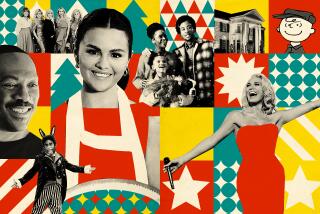Frank Sinatra’s TV specials were special indeed
- Share via
The Chairman of the Board was easily bored.
Frank Sinatra didn’t like to dwell on things. Keeping things moving was his credo. Working in television was anything but quick, so it wasn’t a medium he embraced.
“I love the fact that he was very impatient,” says Bill Zehme, author of 1997’s “The Way You Wear Your Hat: Frank Sinatra and the Lost Art of Livin’.” “That was the drawback of him doing TV. Thank God, he was uncomfortable with TV. If he had taken to it like a fish takes to water, it wouldn’t have been as literally as special when he did do TV.”
In the mid-’60s, Sinatra found a format on television that fit his larger-than-life persona and captured his artistry. “A Man and His Music,” which aired on NBC on Nov. 24, 1965, featured Sinatra accompanied by a large orchestra with Gordon Jenkins and Nelson Riddle sharing conducting duties. He performed some of his greatest hits such as “I’ve Got You Under My Skin,” “My Kind of Town” and “I Get a Kick out of You.”
There’s also a memorable ballad sequence in which he performs “It Was A Very Good Year” interspersed with a medley of “Young At Heart,” “The Girl Next Door” and “Last Night When We Were Young.”
The formula was such a success that Sinatra continued with “A Man and His Music” specials throughout the rest of the decade. Those specials, plus several he did in the 1970s and ‘80s, appear on “Frank Sinatra: The Concert Years,” a new DVD set from Shout! Factory. The DVD set includes 14 hours of TV and concert performances — including a bonus disc of his work from the 1950s — a book featuring rare photographs and notes by Zehme. On Dec. 14, Shout! will also release one of the specials, 1982’s “Concert for the Americas,” as a single disc.
The real rarity in the collection is 1985’s “Frank Sinatra in Japan: Live at the Budokan Hall, Tokyo,” which was made available only in Japan.
“I think when Frank turned up on television, it was an event,” says Zehme. “Those first couple of ‘Man and His Music’ specials are spectacular shows. It was at the perfect moment. Frank was at his height. He was always at the apex no matter where he was, but in terms of his powers they were just perfect in the mid ‘60s to the late ‘60s. He was a vital guy who was dangerous. It was thrilling to see him in the shows.”
Charles Pignone, who is an executive producer on the set as well as a Sinatra archivist, was in his 20s when he accompanied Sinatra on tour during the last decade of his life. “Watching these [TV] performances are spectacular. But it’s nothing like seeming him in person. There was a palpable tension and excitement in the arena not witnessed with any other performer. I have never seen anything like the response he could get from the audience. I think on some of the TV shows you can see it.”
Watching the specials, Pignone adds, illustrates Sinatra the perfectionist and performer. “It was a master class in singing. I think that’s why he was a great actor, he would get himself involved in the lyrics.”
He was one of the few performers that actually paid credit in his specials not only to the composers but also the arrangers whether it be Riddle, Don Costa or Quincy Jones. He “made these people who are well-known today special,” says Pignone. “He recognized their talent and he put it up on the forefront. It was not about his ego.”
The crown jewel of the DVD set, says Pignone, is 1967’s “A Man and His Music + Ella + Jobim,” which finds Sinatra sharing the stage with the great Ella Fitzgerald and the Brazilian composer, guitarist and singer Antonio Carlos Jobim. Jobim accompanies Sinatra on “Change Partners,” “I Concentrate on You” and “The Girl From Ipanema.” Then Sinatra and Fitzgerald bring down the house in front of an intimate audience with “They Can’t Take That Away From Me” and “The Lady Is a Tramp.”
“I don’t think we’ll ever see the likes of probably the greatest hour of music on TV,” says Pignone. “Not just because of those talents, but also the size of the orchestra. It was pop music back then, but I think people appreciate it today as high art. The passion he had for singing comes through in these shows.”
More to Read
The complete guide to home viewing
Get Screen Gab for everything about the TV shows and streaming movies everyone’s talking about.
You may occasionally receive promotional content from the Los Angeles Times.







